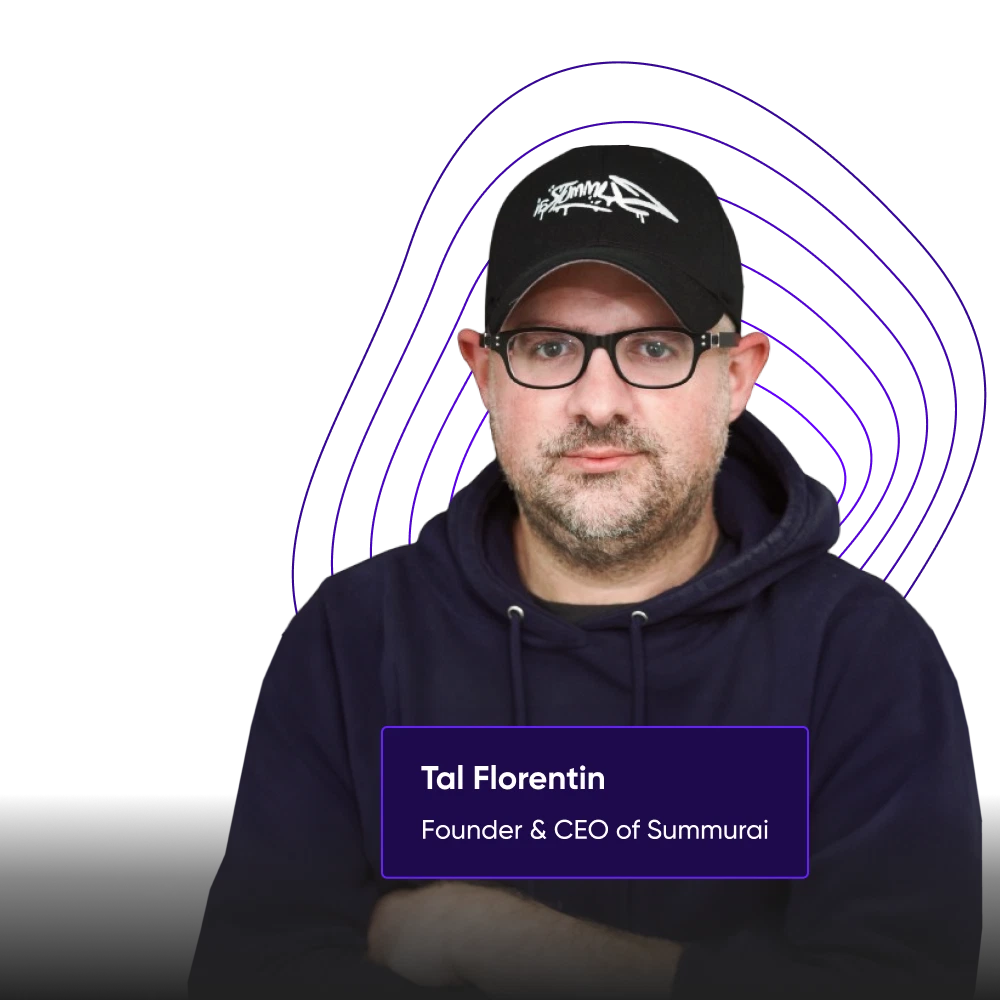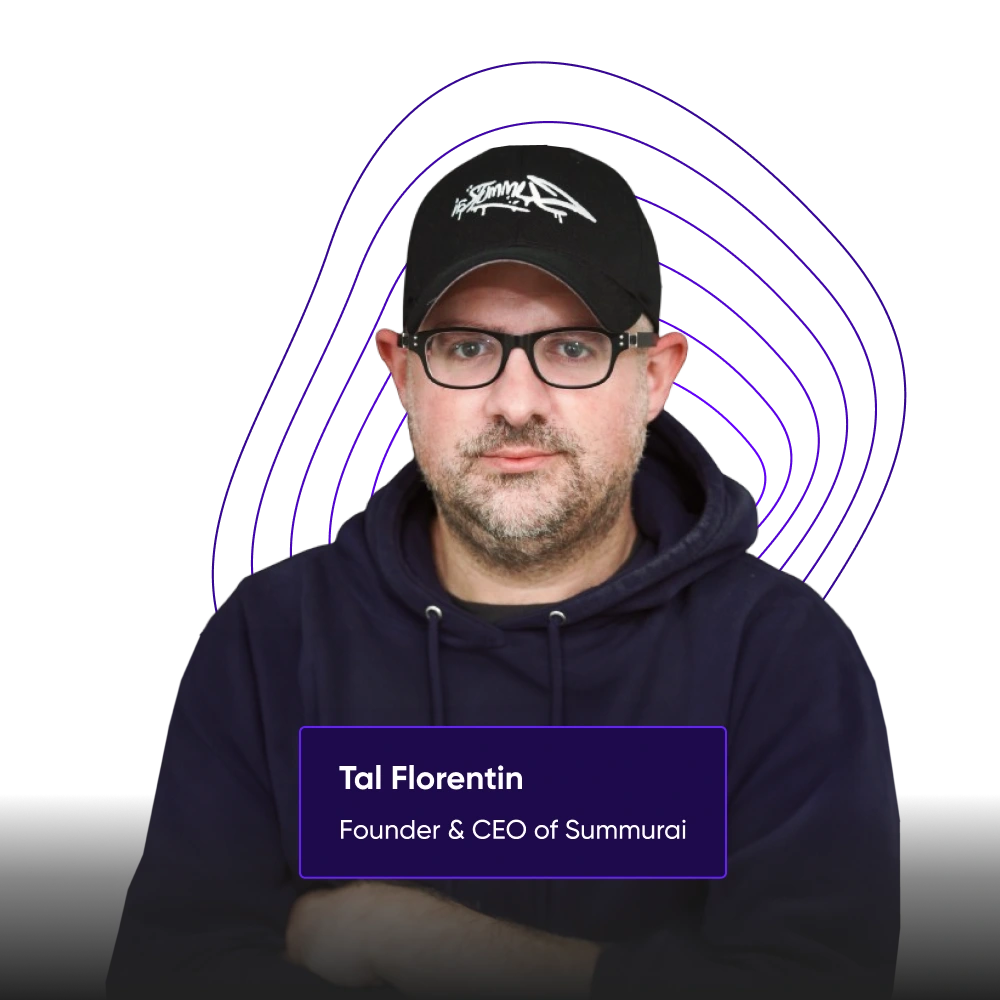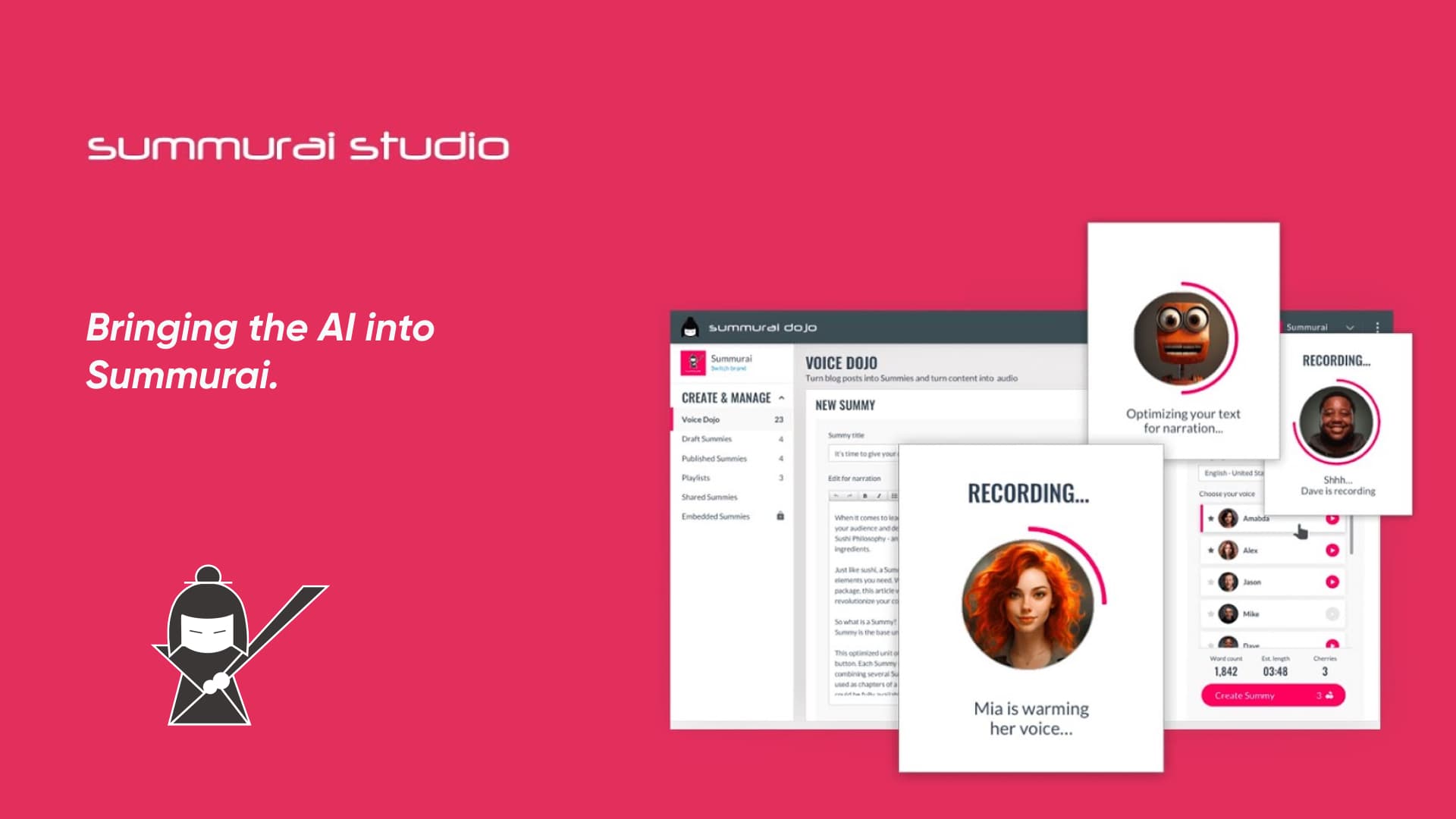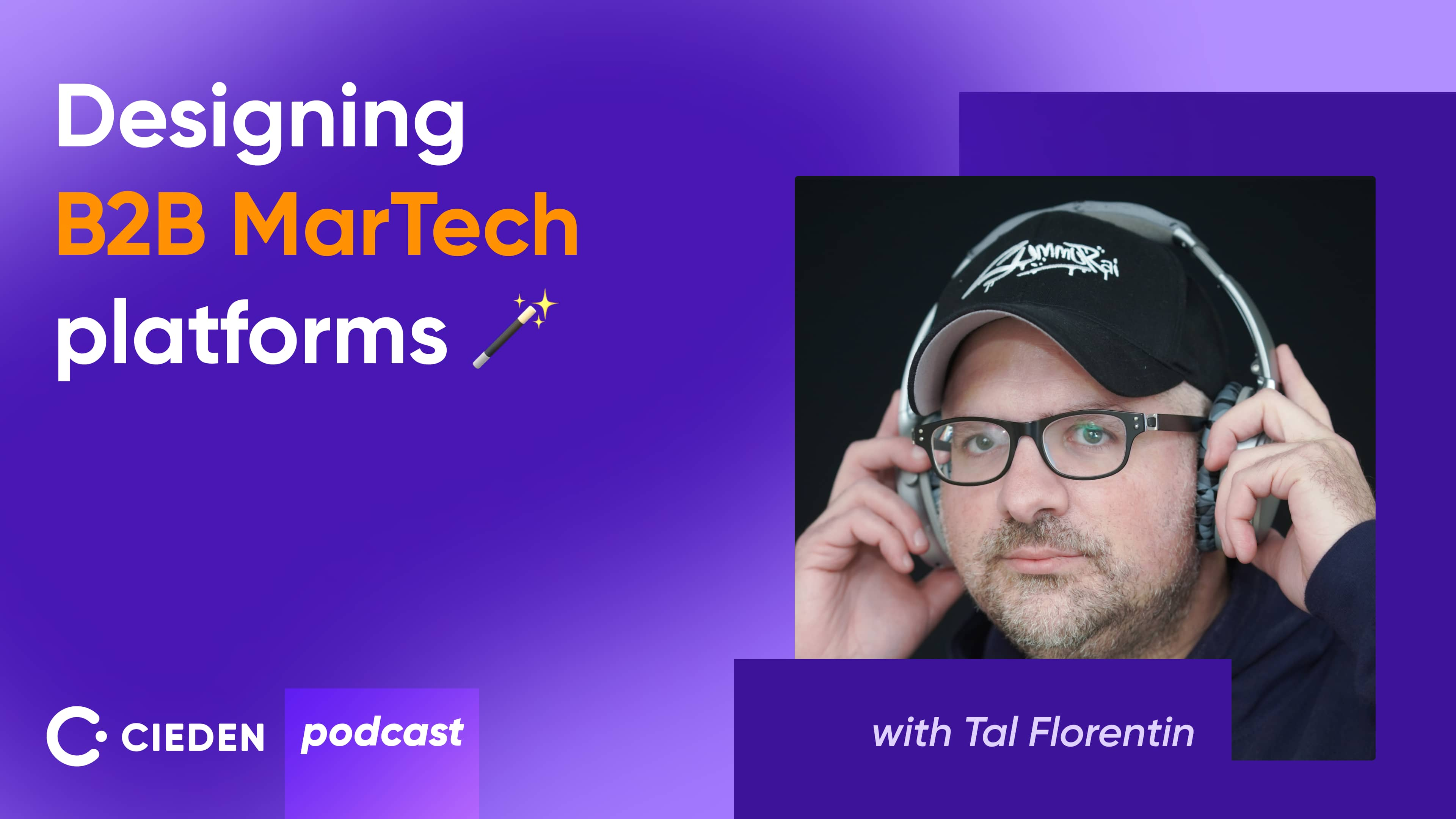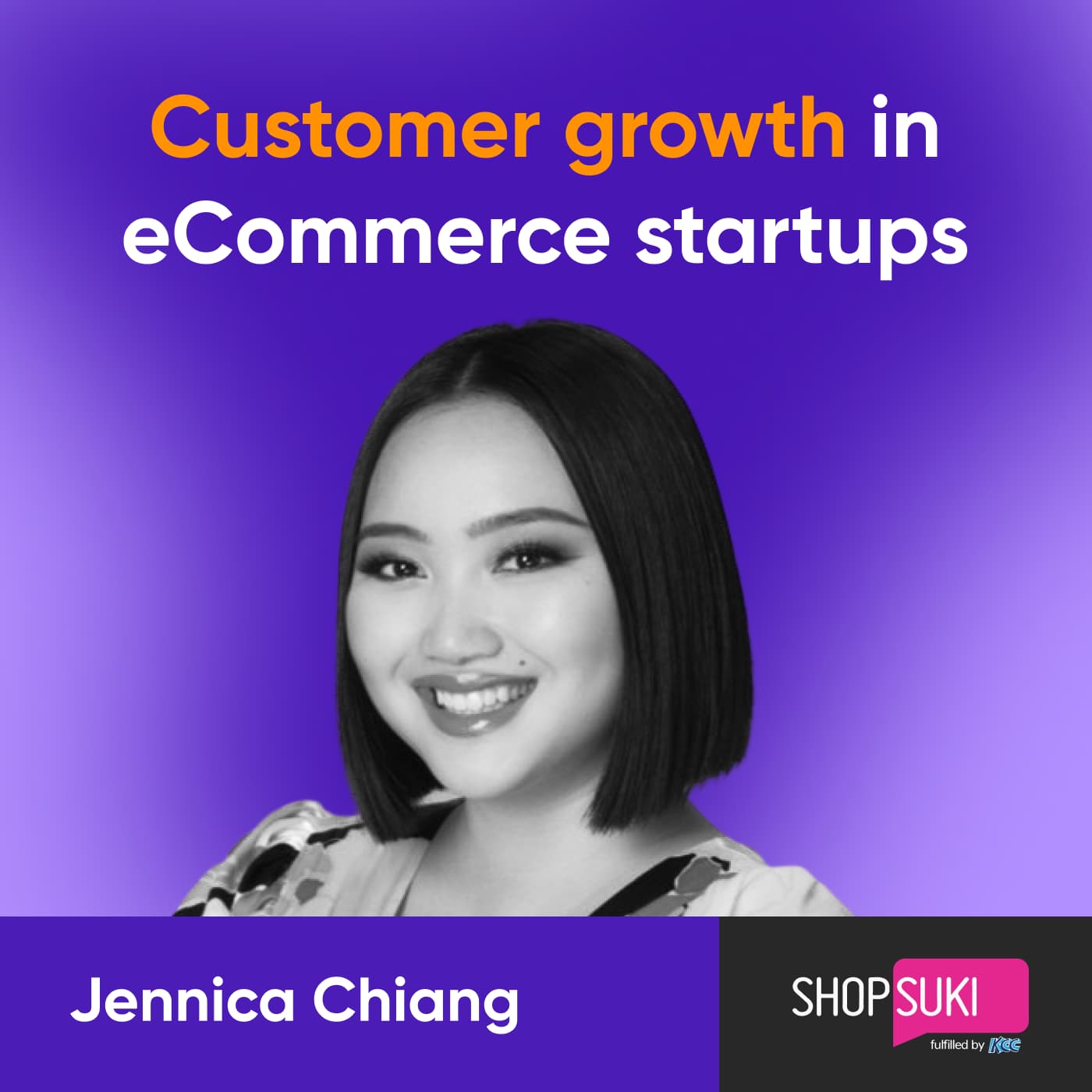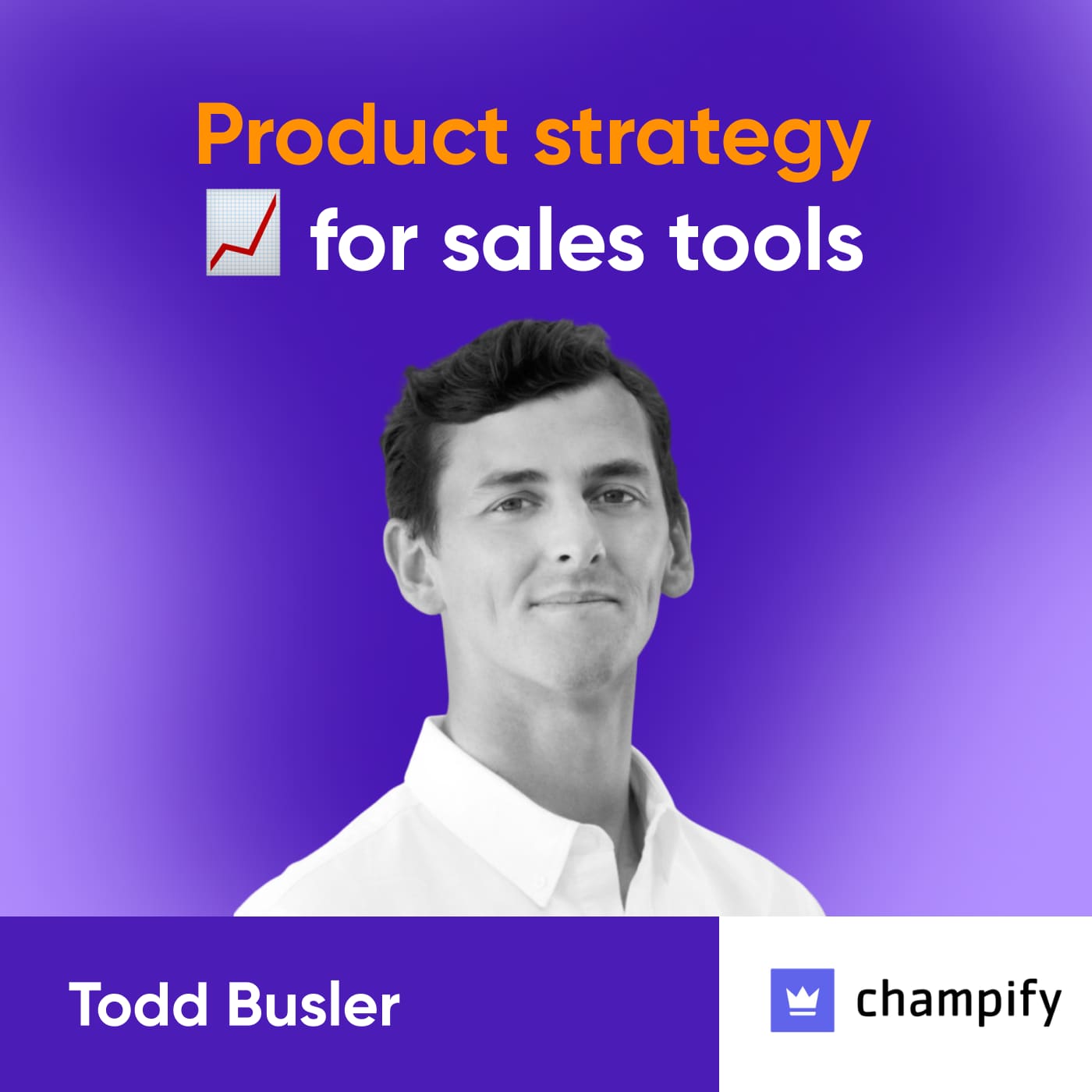This time around, we've got the scoop with a UX maestro who's brought 250 digital dreams to life—Tal Florentin. He's the brain behind Summurai and the author of two books: 'Design for a Perfect Screen', 'Upwork Hacks.'
What sets Tal's journey apart is that Summurai wasn't on point when the startup was launched. Tal had to pivot two times to find out what value his team can deliver to users. And thanks to AI technologies, Summurai now is shaping up to be the go-to for B2B marketers, making them the heart of its universe.
In this episode, you'll learn about:
- Mindset shifts needed to become a Designer Founder
- Trade-offs vs pixel-perfect design
- The future of AI and audio technologies
Give it up for Tal and our Cieden Podcast hosts:
🎙 Anastasiya Mudryk, the mastermind leading BA&PdM at Cieden
🎙 Yuriy Mykhasyak, Co-Founder and CEO of Cieden
Transition to Founder and CEO roles
Anastasiya: Tal, we're really happy to have you today on Cieden Podcast. Thank you for visiting us.
Tal: Thank you for having me. I'm happy to be here.
Anastasiya: Tal, tell us about your transition from being a designer to becoming the founder of the startup. I bet there were some shifts in your mindset when you decided to launch a startup.
Tal: Sure. I guess one of the most important elements in my transition was that moment when I’ve just moved into design. I was looking for algorithms to optimize the design, and I didn't find any. So, I was going to create my own design algorithms to make sense of why I am doing things a particular way. The answers ‘Well, because I'm feeling good about it’ or ‘This is what fashion is now’ weren’t enough for me. I was looking for a logic which would reveal customer experience design to me.
Over time, I used that method to design products for many companies. I have designed more than 250 digital products or 7.5 billion pixels so far. After doing that much decision making on designs where you get a request, I’ve been always trying to figure out how technology engages with human beings.
At a certain point, I decided to step into entrepreneurship. Summurai wasn't my first startup. I had a prior project – a platform for managing persona profiles. It was a tool for product designers, user experience designers, and product managers. With this tool, they were able to share insights about their target audience and manage persona profiles with images.
It was a very niche product, and at a certain point I left it and moved forward. Eventually, I launched Summurai, and it was kind of a startup that chose me instead of the other way. Before Summurai I was always bored doing things I already knew. I was always trying to move to the next chapter. That’s why I had some sales and marketing skills before becoming a designer.
To sum up, I believe every founder has the need to explore and try new things. You have to feel comfortable testing areas where you’ve never been before if you want to start your own business one way. And the moment when you realize that you have this enormous need is the moment where transition happens.
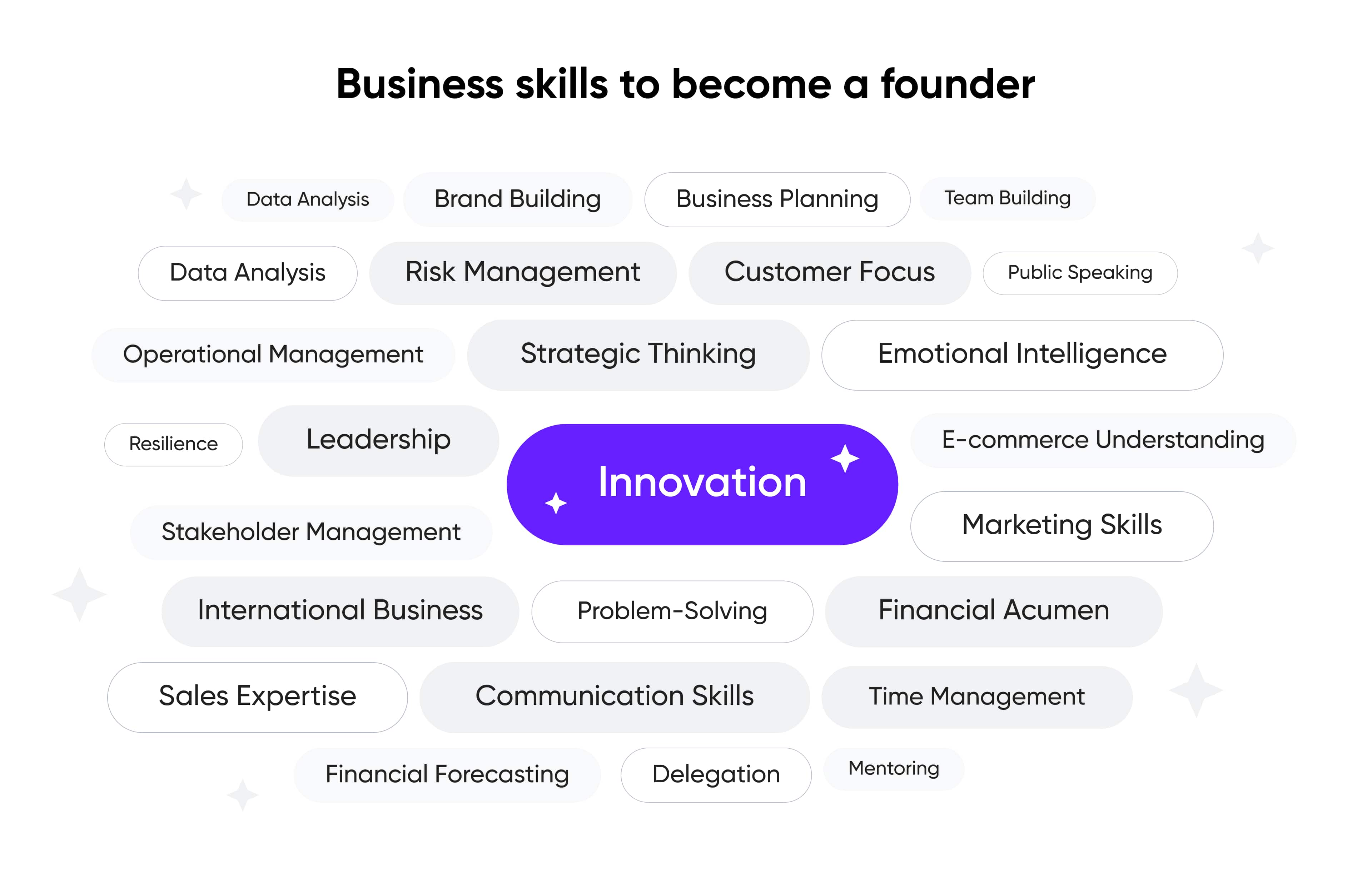
Anastasiya: Wow, such an inspirational story!
Pivoting your product to increase sales
Anastasiya: Tal, as we know, products sometimes find their own path. Just like you mentioned that there was a need, then ‘Bam!’ – you have a solution. Great. But I also know that you already have a few attempts at pivoting the product, the startup idea. So I'm wondering, was there any trigger that prompted you to pivot?
Tal: So, looking at the journey of Summurai, you find two main pivots: moving from B2C to B2B2C, a common transition for many companies. We started by offering a service that provided a way for busy people to stay up to date with content. The basic idea at the beginning was that whenever you bumped into content on the web, you would send it and create an audio summary for the article. This concept was eight years ago.
So, I'm talking about now having automatic audio that would work, and the service was based on human beings. There were students who were doing the summary, and others were recording the audio. We launched that, and it was pretty awesome, besides the business model because we couldn't find a way for users to cover the costs. I didn't want to build a company that's losing money. So, then there was the move into, okay, so we were doing something right with the end-users. Let's find our methods for bringing buyers, which are companies with their marketing budget or so. So, we moved into trying to make sense around the world of conferences because there's a small amount of content and a lot of users. And then we moved into B2B content marketing and started building tools for allowing busy people to consume blog posts in a much more effective way.
And I think one of the things that's happened is maturity and understanding of audio. If I'm talking about five years ago when I was explaining audio, people didn't get it. Even the most advanced professionals were talking about video. And we're asking what kind of their idea about audio was. It feels like we're going back from TV to radio state of mind of where we have TV. Why would you go backwards and bring a radio? What's the sense of that? And from my point of view I figured out that I was able to know much more by using audio because it fell into times where I wasn't in front of something. I was driving that stuff like this. By the way, I figured out how audio works for me eight years ago, when there were no podcasts to talk about and nobody did what we do now yet.
I then started my own service. I hired somebody to create summaries for articles that I'm not going to read. And when I saw that, I'm not reading the summaries. I asked a professional voice over narrator to record them and send them to me via email. When I started listening to these files, I was able to talk as a speaker. I even made a lecture about an article that was published on Forbes and nobody figured out that I didn't read the article.
That was the moment when I thought that audio tools are interesting as a business idea. Afterwards, I worked on this value. But the market wasn't ready to talk about audio. So I decided to wait and keep building a tool and optimizing its messaging. As a result, nowadays we bring such a wide variety of abilities that are so mature. And we have that ability because we started very early.
Factors that change the market
Yuriy: As for market readiness, there are like three areas that bring changes and open new windows of opportunities for new applications, new solutions. One is technology push. When there is new technology that opens some opportunities and the other is demographic changes, like something changes in people's lives and suddenly they want to listen to audio and maybe some regulation or changes do see some actual changes. What changes can be the window of opportunity for products like Summurai?
Tal: Audio is not new. When we had video, we already had audio. In a way, we're bringing something already there, but it found its way into our lives because the connection between technology and human beings changed. We live in an era of too much information. Everybody needs to know so much about everything. Learning has changed; we need to learn in a wide way, not just a specific topic. We need to know everything about everything, but we don't have time. We read less, and audio became a solution. It bumped into our lives and offered a new option to consume knowledge.
I always talk about two types of knowledge: the knowledge you need, for example, to code in Python. Audio is not the way, otherwise it will be just a bad customer experience. I'm not going to listen to a podcast and imagine code written. It doesn't work like that. I need 100% attention. But for the rest of the content, we can't find that 100% attention because we have other things to do, and then we need a solution for that.
Audio became the solution. It's not technology; it's maybe more related to demographics. It's more related to how we changed our behavior and how technology affected our lives. This moved us too to that category. As audio evolves, this is the next step. Look at the video, for example. Video became widespread, and companies needed to use it. Tools evolved, like Vimeo, which provides ways for businesses to implement video. With audio, it became widespread; we all know Spotify and Apple Podcasts, but now comes the era where businesses want to use it. It's pretty much limited because you can create a podcast and put it on Spotify, but you will not get lead generation; it will not be hosted properly on your website. You will not get a call to action button leading to whatever you need to do properly. There are many limitations because you're stuck in somebody else's playground.
We figured out that as audio evolves, it will become a tool for businesses. Businesses keep creating an endless amount of textual content on their blogs and white papers, even though the podcast category is evolving. They do so because it doesn't provide them the tools they need. The next evolution is figuring out that the category of audio needs a business solution. This is where we want to get in and provide all of that. The last element, which breaks the major change, is AI or audio-based AI becoming good enough to work with. Until a year ago, it wasn't good enough; you wouldn't put your logo on top of audio created by technology because it sounded okay, not good enough. With the evolution of AI, production of audio content became a two-minute issue, and now another door is open. We need to bring it again into the world of business and provide a tool that allows you to use that for your messaging and communication.
When you get all these tools together, once it is audio and technology, and the other side is podcasts, offering and putting it in the same place, this is where kind of magic happens. This is where we're just about to launch our self-service for the first time, which will allow creating audio with no need of human beings, even though in some cases you will get to a point where you say, okay, this is good, but I think I'll bring the human narrator as well, because they want it even more personalized or it's worth the effort. All of the other elements are covered. So I think technology changes, and we're in a very interesting time where everything is kind of combining into one story.
Yuriy: I guess there are some other changes also coming, like recently announced changes to Internet protocols that will provide us zero latency in the Internet, almost zero latency, because you can break the laws of physics, but streaming games and everything will be instant. And I don't know how to use it because buffering is okay, nobody cares.
Tal: It goes back to if we're able to watch Netflix on a smartphone. I think audio is in a good situation. It's been a while since we've been stuck in front of an hourglass so kind of where I think we're in a good position if it's going to be better, that's awesome.
Yuriy: I don't know if you're into this topic, but then do you think about getting back to your initial idea? Because I think that's currently a good program. Somebody to search the content, to summarize it, and then have the ability to read it aloud. Then you have the product and the fixed problem.
Tal: It's a funny question because this journey goes back to the initial idea. We are definitely going to do that because when I look at the vision, I want to bring audio to businesses and allow them to communicate better. This will increase engagement for end-users who will enjoy knowledge, making communication much easier for everyone. Then, the market of content and the consumer element will return to the story, and we will combine everything. I'm committed to returning to the original plan and covering that with a second product that will work in parallel and combine.
However, at this point, the idea of providing businesses with tools that leverage AI and audio is a big enough mission and worth focusing on. So, for now, we're staying in that position and optimizing it. This is still early for the market to figure out. It's just beginning to be relevant. We don't need to explain podcasts and why audio is relevant because when we talk to people, they are already listening to audio. Why not convert that interesting whitepaper, left in the download folder, into something they can listen to during a traffic jam? Everyone will enjoy it. We want to convert that information into something that brings them down the funnel and closer to decision-making. Let's make it happen.
Yuriy: Our conversation sparked my idea for how to look for new startup ideas. You have to just get the list of all startups that have to pivot or close because their cost of doing business was too high and see if thanks to eyes, that's changed. Now, it's possible to do it simply. I think that I'm sure you would get hundreds of ideas that not even if they're waiting, if their timing wasn't perfect previously, but now it's time to do it differently.
Anastasiya: Yeah, I think that's regulations or the changing policies also could be an opportunity for products as yours, because just recently in September, Google has released Google helpful content policy and that actually pushes companies or in Google, they prioritize those resources that are more engaged with users so I think that if this just opens possibility for your product, that's helping companies to make their content more helpful to users, they can also scale and are.
Yuriy: Recently, people were just producing textual content just for Google to get to the users, but it doesn’t work anymore. The B2B customer experience has changed. Now you have to engage leads differently. And as I noticed, there’s also a trend of digital detox in the B2B community. Everybody is saying, ‘We are spending too much screen time. We have to disconnect from our devices.’ At the same time, we have a digital natives generation, the people who like listening to podcasts all the time.
Tal: I'll give my point of view on that. First, we could use our tools as an accessibility tool. I was always moving from that area because it's less fun to work with. However, I want to provide a solution for accessibility needs; it's important for us to take that responsibility. Returning to what you mentioned, there's an interesting opportunity we discovered related to audio and blogs. Traffic from SEO leads people to blogs, and a statistic indicates the average time spent on a blog post is 37 seconds, enough to scan the page and decide its interest. People are placing play buttons on their blogs, and customers have asked us to allow them to do so.
From a user experience perspective, I've felt uncomfortable with this because the issue isn't about reading or listening; it's about managing open tabs. Thinking about this from a design perspective, we found a different solution, which we called 'later' — a mix of 'play' and 'later.' Instead of reading now, why not send this item to listen to later? I have a traffic jam that fits that type of content, but there's no connection between desktop and mobile content. 'Later' allows you to send the item so it will wait for you in an audio version on your mobile phone and use a calendar to schedule the right time to listen to content discovered. The main idea is that discovery time is not consumption time; they are different, and we need to bridge them. Echo and audio become partners in a customer journey that begins on a desktop webpage and continues with the same content in an audio version on mobile, ending with a call to action button. This creates a unique combination of user journeys across different devices on the same timeline.
Anastasiya: I'd love to use this feature, as I save countless tabs and bookmarks to read later, but rarely revisit them.
Tal: It's comforting to know they're saved, right?
Anastasiya: Yes, it's reassuring.
Tal: We are great at collecting things we'll never use.
Anastasiya: Exactly. I save valuable resources, planning to revisit them later, but that rarely happens.
Yuriy: YouTube's "Watch Later" feature is so helpful! Building products and using all sorts of audio tools so your listeners can listen later to whatever they want is the most promising customer experience trends out there.
Tal: I think if you take something practical from that, there's too much information and nobody finds ways to work with it. Companies lose because their content, sent out later, isn't being used. I see companies spending a lot of money creating white papers and optimizing the content, going through seven versions of optimization so each word is perfect. Then, people download it but don't spend more than 2 seconds looking at it. They think, 'Wow, it's nice, I'll keep it here,' and never use it. As a result, companies lose because their message isn't delivered.
Yuriy: That's an interesting perspective. Sorry for interrupting, go on.
Tal: No problem. Converting content into playlists not only makes it more consumable but also increases the likelihood of the audience understanding and engaging with the content.
Yuriy: For businesses, there are two main challenges: discoverability and content consumption. Discoverability involves making people find their content, which some businesses address with search engine optimization and other marketing strategies. Consumption involves getting people to use the content at a convenient time. Audio and video segments like YouTube and podcasts are growing rapidly because they solve discoverability issues, allowing businesses to place their content amid what users are searching for. This is effective for search, as users often find what they're looking for on YouTube and Google search results. If businesses can help people discover and conveniently consume their solutions like YouTube, which offers a 'watch later' feature, they will succeed. Unfortunately, podcast platforms struggle with this, which is why YouTube continues to grow.
Tal: Interestingly, YouTube, known for video, is increasingly used for audio content, with creators adapting content for the platform. YouTube's Pro model even monetizes audio content, indicating a significant shift towards audio-focused solutions.
Yuriy: Yes, I’ve read the research that shows that most people use YouTube for listening, or at least they prefer a hybrid usage. And audio popularity keeps growing.
Audio opportunities for governmental projects
Yuriy: We like to dream at Cieden to see the bright future when, like in five, ten years, robots will do everything for us and they will be just happy with how the world is looking now. Like, just like to want to have a chat. Maybe you will share your vision of the future thanks to new technologies. In your area. So what do you think, like, is it possible that in the future, every website, especially governmental websites, will have options for us to listen to their content, not just to read what they have? Is there because technologically it's possible, but still lots of brands are not super friendly and accessible. So can we solve this problem or not?
Tal: You mentioned the government, interestingly perceived as the last to innovate. However, I'm leading a project integrating our technology into one governmental digital customer experience strategy. We have four government offices sharing information this way. But, as you probably imagine, government websites, with hundreds of offices trying to communicate, are not the best communicators. They usually share what they need to say instead of asking what you need to know. Our customer experience design lacks that point of view.
They have so many messages and offices, resulting in websites with complex and poor customer experience optimization. Even with the best designers, it's like building a city so complicated that it's problematic to navigate. In some points, you find messages you can rewrap in a new way. We found in each government office a subject relevant to many people in a specific situation. We want to reduce the friction there and provide a correct explanation.
For example, we're working with an office providing information to people who just lost their job. They need to register and get paid from the country, and there are many regulations and guidelines, written unpleasantly across the website. We figured out it would make sense to bring a guide teaching everything you need to know in that situation.
The problem is the lack of human time to find a guide for each person; we're not going to produce a video course around that, and you're not going to watch it due to time constraints. But, if we were to wrap all this message in an audio-based playlist, you'd listen 10 seconds after starting to find a new job. Then we talk about communication and tone of voice, a term known in design but originating as an audio element. Who's the presenter we're going to bring? Then you take your message, break it into short pieces, and wrap them in a playlist, a complex process as all officers need to accept and approve the content, which goes back to regulation and what you can and cannot say.
It's a horrible process, but you end with a playlist specific and easiest for your audience to consume. It's like a Spotify podcast playlist but not podcast material. It wouldn't make sense for them to live there, and nobody would go there. But it's still audio, so we figured out that audio has many places to live outside the podcast world, and we need that. This is where technology will take us, providing tools to use outside that category and meet needs. Each item has a call to action button, bringing it to the right form on the right web page, reducing the need for you to find it yourself. For me, this is world peace, bringing you the optimized way to consume content by reducing your need to find it. If you go back to discoverability, this is valuable as people start to send it from one person to another. The aim is to reduce the need for you to ask questions, so they send it over as the best way to get to the right place, and content starts to promote itself, our dream.
